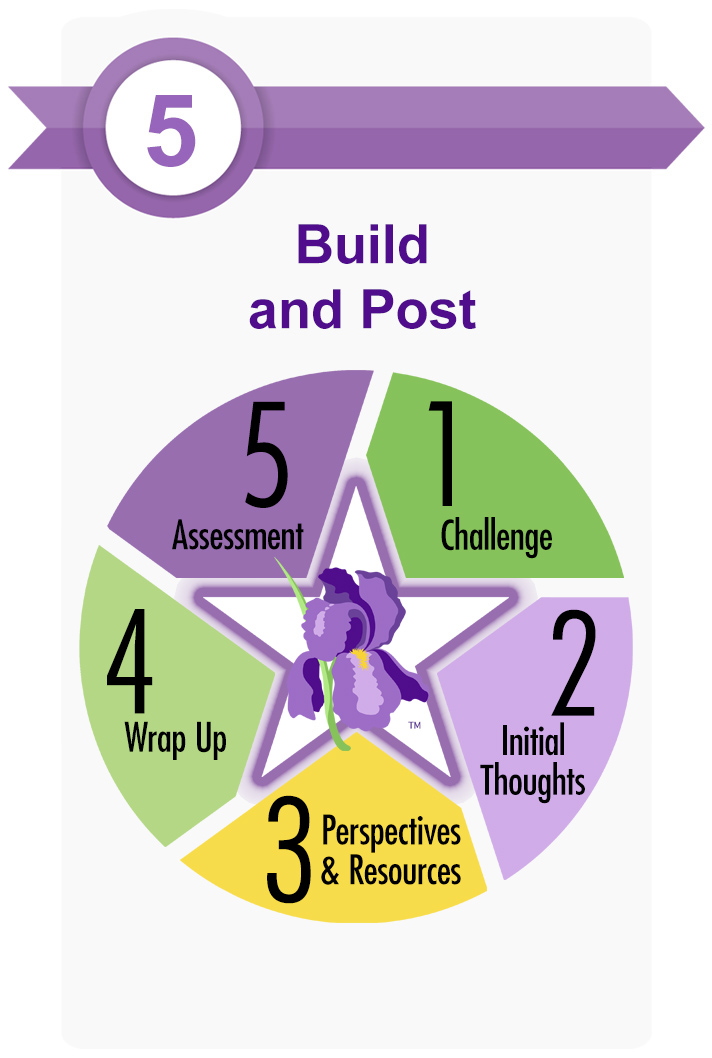The IRIS Module & Materials Development Process
The method by which the IRIS Center creates free online instructional resources is a multi-stage process of topic selection, development, and refinement that relies on the input and expertise of a wide variety of sources. Because the center’s work is informed continually by feedback, the result is an ever-evolving set of resources based on the input and needs of the center’s consumers, constituents, and the federal government.
The figure below illustrates the plan for systematic development of IRIS Modules and materials. The individual components of this process are further described in the paragraphs below.

Input
The purpose of the input phase of the product-development process is to inform IRIS staff about content gaps in preparation programs for preservice personnel as well as in professional development. The input phase involves the collection of data from five major sources: IRIS consumer surveys, stakeholder focus groups, national standards, federal policies, and IRIS website user data. When needed, textbook analyses are conducted to identify potential gaps in course content coverage.
Consumer Surveys – A critical part of the input phase was the national needs assessment survey—posted on the IRIS website and disseminated via listserv notice and through the cooperation of IRIS partners. Respondents tell us what topic areas they would most like to see future IRIS resources cover.
Focus Groups – Stakeholder focus group members are tasked with helping IRIS drill down to more specific subject areas based on the results of the needs assessment survey.
National Standards – National standards—for both academic content and teacher certification—likewise inform and guide the IRIS development process.
Federal Policies – Federal policies also inform and guide the systematic development of IRIS modules and materials. When federal laws, regulations, and policies are enacted or modified, IRIS resources will reflect those changes.
IRIS User Data – This component consists of tracking the IRIS website’s visitor data monthly and consolidating the information quarterly. The center monitors these data to identify trends in topics and use by our consumers.

Topic & Expert Selection
After the input phase, IRIS team members—in collaboration with OSEP—prioritize and select specific topics (e.g., functional behavioral assessment) and determine the type of product to be developed for each topic (e.g., IRIS Module, a case study, or both). Once topics and resources have been selected, IRIS team members collaborate with OSEP to identify nationally recognized content experts to work with IRIS staff to develop content and supporting products for the resource.

Translate Research to Practice
IRIS resources bridge the gap between research and classroom practice. They do so by translating research about evidence-based instructional and behavioral practices into practical information that can be easily understood and implemented by educators. To create those resources, we start with evidence-based content provided by researchers and experts in the selected topic area. IRIS personnel often add supplemental information to provide background or foundational knowledge necessary to understand the topic.

Resource Development
Once all the content is gathered, IRIS content developers transform the subject matter into the appropriate format, adding in perspectives from practitioners, individuals with disabilities and their families, and others with relevant backgrounds and viewpoints. The resource goes through several rounds of internal reviews; at the same time, our media production team creates graphics, illustrations, movies, audio clips, and page templates. The draft product is then sent to an external team member with expertise in both content and instructional design. Feedback from that review is used to revise the resource further. The final internal review is the most intense, where every aspect of every page—phrasing, terminology, graphics, and overall flow—is scrutinized by the entire development team including, when possible, an external faculty or doctoral student with experience teaching the content in college courses. It is then sent back to the original content expert to verify that the team translated the research appropriately. More edits are then made; the resource is sent to a panel of three nationally recognized researchers/content experts. Their reviews are used to refine the content once more. In some instances, content on key topics (e.g., IEPs) is sent to the U.S. Department of Education’s Office of Special Education Programs (OSEP; IRIS’s primary funding source) for approval—where edits are often made again—before posting.

Build & Post
Upon final approval, the resource’s content and graphic elements are organized, formatted, and optimized in the content management system (CMS). To meet 508 and WCAG 2.2 compliance standards for accessibility, alt tags are added to illustrations and photos, and descriptions are provided for detailed graphics (e.g., data charts); videos are formatted and closed-captioning is added; and audio interviews are compressed for optimal online use. Additionally, interactive games and activities are developed. Once the pages are built, IRIS team member perform a final review and revision before making the resource available to consumers on the IRIS website, the center’s primary tool for dissemination.

Consumer Feedback & Revision
Additional feedback is collected through field-testing and the online Module Feedback Form. Modules are field-tested in college courses—each module is used by at least 50 college students—whose feedback is considered from the novice perspective and any identified problems in the module are addressed. Additionally, all consumers have the option of filling out an online Module Feedback Form for every IRIS Module they complete, providing suggestions for improvement. Comments and ratings from this form are reviewed every week; additional tweaks and improvements to the modules are executed as a result.
In Summary
IRIS uses an array of strategies to gather formative data to inform our development process so that modules and other materials address topics with the highest need and greatest demand. Consumer and stakeholder feedback continues to be collected in an ongoing manner, guaranteeing the quality, relevance, and usefulness of both the content and its delivery mechanisms. This meticulous, iterative process is one reason that our modules consistently receive such high ratings in these three areas, and will continue to ensure similar excellence for future modules.
